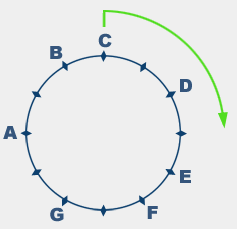The Major Scale
The word scale is not very descriptive. In French, it's 'échelle', meaning 'ladder', which is much better. You go up and down ladders. Scales are the ladders you use to go up and down the notes. It's the way the rungs are laid out that makes them different ... ▼
All western music comes from a mother scale called the Major Scale (It has a couple of other names too: the 'diatonic scale' and the 'Ionian Mode'). It is NOT a sequence of notes, rather it's a sequence of seven intervals spanning an octave.
We already know that there are 12 intervals of one semi-tone in an octave, and that 7 does not go into twelve, so the scale must be uneven. Let's get an idea of how it works with some simple graphics.

The formula for the major scale is Tone Tone Semitone, Tone Tone *Tone* Semitone ... if you remember nothing else, remember this formula. It can start on any of the 12 notes. Notice that there's an extra Tone in the second half, the one that put '*' around. I did this only to show you graphically that this scale is irregular, uneven, asymmetric ... this 'kink' in symmetry of the scale coupled with the 'kink' in the tuning is what makes playing the guitar so frustrating at first. The two discrepancies make it very difficult to see any consist pattern to the fretboard.
Below is that same graph of the chromatic scale showing those intervals. Remember, one 'tone' equals two 'semitones'. I've only shown one octave but the scale keeps repeating in both directions, up and down. The last note of one becomes the first note of the next and vice versa. The notes are often sung as the Do-Re-Mi syllables I've written above the notes, which represent the scale degrees rather than actual notes. 'Scale degree' is simply the number of each note, so "Do-Re-Mi" could just as easily be "One-Two-Three", or "First-Second-Third" ...

To simplify things from now on, I'll use the C scale for all my examples, only because it is made up of all the natural notes (no sharps or flats), and it makes it clearer to see what's going on. But always remember that a major scale is always the same formula no matter which of the 12 you start from. Below is a simple representation of the scale starting at C. Left to right is low to high.

So the Major Scale template consists of 7 intervals, and when applied to the chromatic scale (all notes) selects 8 notes ... BUT, the first and last notes are the same name, so in effect, there are 7 notes in the scale.
 I like to think of the scale as fitting around a clock. Just as there are 12 hours on a clock face, there are 12 notes in the chromatic scale. Thinking of the scale starting at noon, the 7 scale notes will be found at 12, 2, 4, 5, 7, 9 and 11 o'clock. Pictured to the left is the C major scale. It will keep running around and around the clock face, from the lowest notes we can hear to the very highest. We humans have a range of around ten octaves, so ten times around the clock. Dogs probably hear the next three or four octaves. Watch the movie at the top of the page to see how it looks and sounds on the spiral staircase graphic.
I like to think of the scale as fitting around a clock. Just as there are 12 hours on a clock face, there are 12 notes in the chromatic scale. Thinking of the scale starting at noon, the 7 scale notes will be found at 12, 2, 4, 5, 7, 9 and 11 o'clock. Pictured to the left is the C major scale. It will keep running around and around the clock face, from the lowest notes we can hear to the very highest. We humans have a range of around ten octaves, so ten times around the clock. Dogs probably hear the next three or four octaves. Watch the movie at the top of the page to see how it looks and sounds on the spiral staircase graphic.
This uneven scale is the blueprint for all western music. From it comes everything, including all the other scales. It repeats through the octaves, so you can imagine them tagged end to end. Refined over the centuries, mostly through the physics of vibrating strings, the order of intervals should be committed to memory (even if you don't know why yet): "Tone tone semitone, tone tone tone semitone". Scales are not yet music. They do allow for melody, which certainly is music, but more structure is needed for the kind of music we love to listen to. Chords are the main structures and I've dedicated a whole section to them, but first we'll look at the way the major scale works on a guitar fretboard.

Join Our Free Trial
Get started today before this once in a lifetime opportunity expires.
